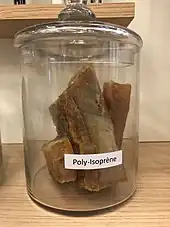
Polyisoprene is strictly speaking a collective name for polymers that are produced by polymerization of isoprene. In practice polyisoprene is commonly used to refer to synthetic cis-1,4-polyisoprene, made by the industrial polymerisation of isoprene. Natural forms of polyisoprene are also used in substantial quantities, the most important being "natural rubber" (mostly cis-1,4-polyisoprene), which is derived from the sap of trees. Both synthetic polyisoprene and natural rubber are highly elastic and consequently used to make tires and a variety of other applications.
The trans isomer, which is much harder than the cis isomer, has also seen significant use in the past. It too has been synthesised and extracted from plant sap, the latter resin being known as gutta-percha. These were widely used as an electrical insulator and as components of golf balls. Annual worldwide production of synthetic polyisoprene was 13 million tons in 2007[1] and 16 million tons in 2020.[2]
Synthesis

In principle, the polymerization of isoprene can result in four different isomers. The relative amount of each isomer in the polymer is dependent on the mechanism of the polymerization reaction.
Anionic chain polymerization, which is initiated by n-Butyllithium, produces cis-1,4-polyisoprene dominant polyisoprene. 90–92% of repeating units are cis-1,4-, 2–3% trans-1,4- and 6–7% 3,4-units.[3]
Coordinative chain polymerization: With Ziegler–Natta catalyst TiCl4/Al(i-C4H9)3, a more pure cis-1,4-polyisoprene similar to natural rubber is formed. With Ziegler–Natta catalyst VCl3/Al(i-C4H9)3, trans-dominant polyisoprene is formed.[4]
1,2 and 3,4 dominant polyisoprene is produced MoO2Cl2 catalyst supported by phosphorus ligand and Al(OPhCH3)(i-Bu)2 co-catalyst.[5]
History
The first reported commercialisation of a stereoregular poly-1,4-isoprene with > 90% cis (90% to 92%) was in 1960 by the Shell Chemical Company. Shell used an alkyl lithium catalyst. 90% cis-1,4 content proved insufficiently crystalline to be useful.[6]
In 1962, Goodyear succeeded in making a 98.5% cis polymer using a Ziegler-Natta catalyst, and this went on to commercial success.
Usage
Natural rubber and synthetic polyisoprene are used primarily for tires. Other applications include latex products, footwear, belting and hoses and condoms.[7]
Natural gutta-percha and synthetic trans-1,4-polyisoprene were used for golf balls.
See also
References
- ↑ Sebastian Koltzenburg, Michael Maskos, Oskar Nuyken, Polymere: Synthese, Eigenschaften und Anwendungen, Springer, Berlin, 2012, p. 424.
- ↑ "Outlook on the Polyisoprene Global Market to 2026 - by Region, Type and Application". GlobeNewswire News Room. 2021-04-19. Retrieved 27 May 2021.
- ↑ Jürgen Falbe, Manfred Regitz (Hrsg.): CD Römpp Chemie Lexikon, Thieme, Stuttgart, 1995.
- ↑ Bernd Tieke, Makromolekulare Chemie, 3. Auflage, Wiley-VCH, Weinheim, 2014, S. 149.
- ↑ 1,2- and 3,4-rich polyisoprene synthesized by Mo(VI)-based catalyst with phosphorus ligand Polymer Science Series B September 2016, Volume 58, Issue 5, pp 495–502
- ↑ "Synthetic Polyisoprene" (PDF). National Metal and Materials Technology Center. Retrieved 27 May 2021.
- ↑ "4 Non-Latex Condoms to Avoid Latex Allergies". Cleveland Clinic. 15 October 2020. Retrieved 27 November 2022.